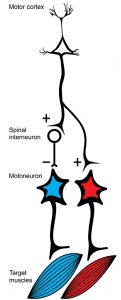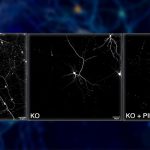It’s well-known that the primary motor cortex drives voluntary movements. This brain region holds the largest population of corticospinal neurons and is the site where electrodes are implanted to control external devices such as brain machine interfaces.

A single neuron in the motor cortex sends signals down to two opposing muscles. Credit: Griffin and Strick, 2020, Science Advances.
As neuroscientists at the University of Pittsburgh Brain Institute, we were surprised to find that a special subset of corticospinal neurons that suppressed muscle activity were also a key component in the production of fast and precise movements.
Pre-movement suppression is a muscle activity pattern, sometimes referred to as the “Hufschmidt Phenomenon,” where the activity of antagonist muscles decrease followed by an increase in the activity of agonist muscles, which produce forces on the joints resulting in movement.
The loss of this pattern has been linked to bradykinesia and akinesia – slowness or outright loss of movement – which are hallmarks of motor disorders including Huntington’s disease, cerebral palsy and Parkinson’s disease .
There are many theories about the function of the motor cortex and what its output commands. Our results, described recently in Science Advances, demonstrate that one of the fundamental building blocks of cortical motor control is the suppression of muscle activity.
This finding — paired with our previous report that the primary motor cortex generates individual bursts of muscle activity that function to generate the movement, fixate the limb and slow down the movement — offers a clear insight: The cortex generates each muscle function separately and uses active suppression to ensure the exact timing of each of those components.
Just as Michelangelo revealed the angel in the marble by carving away the superfluous stone, neurons that produce suppression of muscle activity can remove excitation to sculpt the peaks and valleys of muscle activity with the precision necessary for dexterity.









